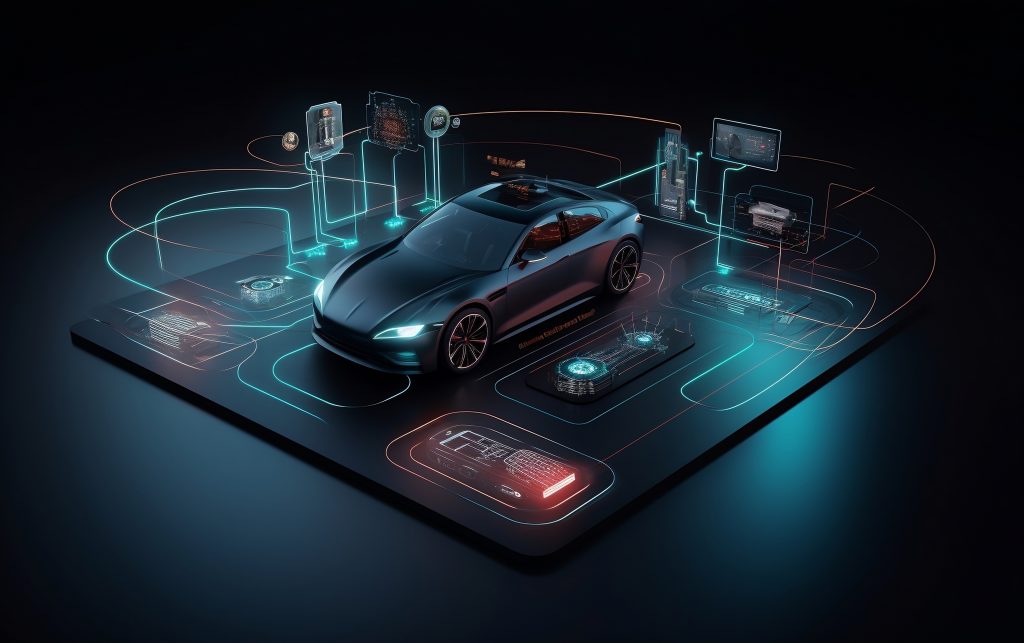Curious about the ways in which Tesla integrates artificial intelligence (AI) into their cars? Prepare to be intrigued by the innovative ways in which Tesla harnesses the power of AI to revolutionize the driving experience. From their pioneering Autopilot system to advanced features like summon, battery management, and navigation, Tesla’s AI-powered technologies enhance safety, convenience, and performance. But that’s not all – there’s so much more to explore. So, let’s dive in and uncover the incredible ways in which Tesla utilizes AI to create a personalized, efficient, and safe driving experience.
Autopilot and Driver Assistance Features
Tesla’s Autopilot system, a groundbreaking feature in their cars, utilizes advanced AI algorithms and sensors to enhance driver assistance and improve overall safety and performance. With the help of AI algorithms, Tesla’s Autopilot system is able to analyze sensor data in real-time, allowing it to make informed decisions based on changing road conditions. This advanced technology not only enhances safety but also contributes to the overall advancement of AI in the automotive industry.
In addition to Autopilot, Tesla’s cars offer a range of other AI-powered features that further enhance the driving experience. For example, AI-powered summon allows users to remotely move their vehicles using object detection and tracking algorithms. This feature not only adds convenience but also ensures safety by avoiding obstacles in real-time.
Moreover, Tesla’s battery management system (BMS) utilizes AI algorithms to predict energy requirements based on driving conditions. By optimizing energy usage, the BMS maximizes the car’s range and conserves energy, enhancing both efficiency and performance.
Tesla’s navigation system also benefits from AI technology. It uses real-time traffic data and AI algorithms to optimize routes, avoiding congestion and suggesting alternative paths. Deep learning and reinforcement learning techniques analyze traffic patterns, adapting to changes and providing personalized routes based on driver behavior.
Furthermore, Tesla’s cars are equipped with adaptive suspension, which adjusts the suspension based on road conditions. Machine learning algorithms analyze data from sensors and cameras, making real-time adjustments for a smoother and more comfortable ride.
Lastly, Tesla’s dog mode demonstrates their commitment to customer satisfaction. This unique AI feature uses image recognition to detect the presence of pets in the car and maintains a comfortable temperature for them while the owner is away. This attention to detail and customer-centric approach sets Tesla apart in the automotive industry.
AI-Powered Summon and Battery Management
Now let’s explore two more remarkable AI-powered features in Tesla cars that further enhance the driving experience and optimize energy usage: AI-Powered Summon and Battery Management.
AI-Powered Summon allows for remote vehicle movement, giving you the convenience of parking and retrieving your car without being inside it. Using AI algorithms, the car recognizes and responds to its surroundings in real-time. Object detection and tracking help the car avoid obstacles, while predictive modeling anticipates movements and adjusts the car’s trajectory accordingly. This feature not only saves you time and effort but also ensures a safe and smooth parking experience.
Battery Management is another AI-powered feature that optimizes energy usage in Tesla cars. The Battery Management System (BMS) predicts energy requirements based on driving conditions. By collecting data from various sensors, the BMS adjusts the car’s performance to optimize range and conserve energy. It communicates with the navigation system to plan efficient routes and further enhance energy efficiency. With the help of AI algorithms, the BMS continuously improves energy efficiency and enhances the overall driving experience.
Navigation and Traffic Optimization
To optimize navigation and traffic flow, Tesla’s cars utilize advanced AI algorithms and real-time data analysis. The navigation system in Tesla vehicles leverages traffic analysis and route planning to provide efficient and personalized suggestions to drivers. By continuously analyzing real-time traffic data, the system can update routes and provide alternative options to avoid congestion. This helps drivers save time and reduces frustration on the road. The AI algorithms used in the navigation system employ techniques such as deep learning and reinforcement learning to analyze traffic patterns and adapt to changes in traffic and road conditions. Additionally, the system learns from driver behavior, allowing it to suggest personalized routes based on individual preferences. Tesla’s navigation system also benefits from the integration of real-time updates, ensuring that drivers have the most up-to-date information about traffic conditions. With its advanced AI capabilities, Tesla’s navigation and traffic optimization features enhance the overall driving experience by providing efficient and congestion-free routes to drivers.
| Traffic Analysis | Route Planning | Real-Time Updates |
|---|---|---|
| Analyzes traffic patterns and congestion levels | Determines the most efficient route for the destination | Provides real-time information about traffic conditions |
| Adapts to changes in traffic and road conditions | Considers multiple factors such as distance, time, and road conditions | Updates routes based on real-time data |
| Learns from driver behavior and preferences | Suggests personalized routes based on individual preferences | Ensures drivers have the most up-to-date information about traffic conditions |
Adaptive Suspension and Comfort Features
The Adaptive Suspension and Comfort Features in Tesla cars utilize advanced AI algorithms and sensor data to enhance the driving experience and provide a smoother and more comfortable ride. AI is integrated into the adaptive suspension system to continuously analyze data from sensors and cameras, allowing the system to make real-time adjustments based on road conditions. This adaptive suspension technology maximizes comfort by adapting to new road conditions and driving styles, ensuring an optimal driving experience.
In addition to the adaptive suspension, AI is also employed in the climate control system of Tesla cars. The AI algorithms use personalized settings to automatically adjust the temperature and airflow based on the driver’s preferences. This ensures that the cabin is always at the desired level of comfort, whether it’s a hot summer day or a chilly winter morning.
Moreover, AI plays a role in predictive maintenance, which helps prevent potential issues and optimize the performance of the vehicle. By analyzing data from various sensors, AI algorithms can detect patterns and identify potential problems before they become major issues. This proactive approach to maintenance reduces downtime and improves the overall reliability of Tesla cars.
Dog Mode and Customer Satisfaction
As we explore the topic of Dog Mode and Customer Satisfaction in Tesla cars, let’s delve into how this innovative feature enhances the overall driving experience and exemplifies Tesla’s commitment to customer-centric innovation. Dog Mode is an AI-powered safety feature that ensures the comfort and well-being of pets left inside the car. With Dog Mode activated, the climate control system keeps the interior of the car at a safe and comfortable temperature for pets, even when the car is parked. This feature provides peace of mind to pet owners, knowing that their furry companions are safe and comfortable while they are away.
Tesla’s Dog Mode demonstrates the company’s dedication to customer satisfaction by prioritizing the safety and comfort of both drivers and their pets. By integrating AI into the climate control system, Tesla has created a solution that addresses the concerns of pet owners, ensuring their satisfaction with the driving experience.
In addition to the safety features it offers, Dog Mode also highlights Tesla’s commitment to innovation. By utilizing AI in cars to provide climate control for pets, Tesla continues to push the boundaries of what is possible in the automotive industry. This customer-centric approach sets Tesla apart and contributes to its reputation as a leader in AI technology.
Advanced AI and Robotics Efforts
Tesla’s advanced AI and robotics efforts have positioned the company as a leader in autonomy development and deployment in both vehicles and robots. Their approach is based on advanced AI for vision and planning, supported by efficient use of inference hardware. Tesla aims to achieve full self-driving and bipedal robotics, believing that their approach is the key to a general solution for autonomy.
These technical approaches highlight the importance of AI in vision systems, neural networks in robotics, Tesla’s FSD chip, AI in perception systems, and advanced algorithms for autonomy. By leveraging these technologies, Tesla is able to enhance the capabilities of their vehicles and robots, improving safety, efficiency, and overall performance.
Use of AI and Big Data Analytics in Self-Driving Cars
In self-driving cars, the use of AI and big data analytics revolutionizes the way vehicles analyze and respond to their surroundings. AI algorithms, combined with data from sensors and cameras, enable self-driving cars to make real-time decisions to avoid accidents and ensure safety on the road. By continuously collecting and analyzing data, the AI systems in these cars improve their performance over time. They can optimize routes, adjust speed and handling based on road conditions, and even personalize settings and features for a more customized user experience. Additionally, AI and big data analytics help in predictive maintenance by detecting potential problems with the car’s systems and notifying the owner before they become major issues. This reduces downtime and improves reliability. Overall, the integration of AI and big data analytics in self-driving cars leads to significant safety improvements, performance enhancements, a more personalized user experience, and efficient predictive maintenance.
Read next:



